A Primer on Economic Growth and Biodiversity Conservation for COP15
by Brian Czech
With COP15 coming up, it’s time to don the old conservation biologist hat and proffer a primer on the relationship between economic growth and biodiversity conservation. The last thing we want is a COP15 devoid of discussion about the fundamental conflict between growing the economy and conserving biodiversity. In fact, the 800-pound gorilla—GDP growth—ought to be front and center.
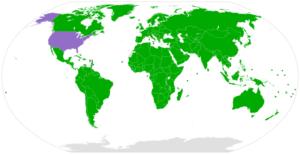
Why is the USA the only major non-party to the Convention on Biological Diversity? Because no other country is more obsessed with GDP growth. (CC BY-SA 3.0, L.tak)
For the uninitiated, COP15 is the UN Biodiversity Conference, to be held in Montreal from December 7-19. It’s called “COP15” because it’s actually the 15th meeting of the Conference of the Parties (COP) to the UN Convention on Biological Diversity. The original meeting was at the 1992 Earth Summit. The Conference of the Parties, then, is a vast international, bureaucratic structure that has taken on a lengthy life of its own, similar to that other “COP” structure on climate change, where COP26 was the recent iteration. (And yes, the “good COP bad COP” puns abound, although neither COP has been particularly effective.)
The goal of the parties at COP15—or at least the most serious conveners of the conference—is to adopt the “Post-2020 Global Biodiversity Framework.” My goal right here (and at COP15) is to demonstrate that no framework can be effective as long as the overriding goal of the parties is GDP growth.
What is Biodiversity?
Biodiversity is the variety of life. To anyone with eyes or ears, biodiversity is beautiful, fascinating, and awe-inspiring. It accompanies the sacred—it is the sacred—in the hearts and minds of many. And for everyone, whether they know it or not, biodiversity is crucial for the functioning of healthy ecosystems that are capable of providing us with food, clothing, shelter, and a long list of ecosystem services. Economically, then, biodiversity is priceless.
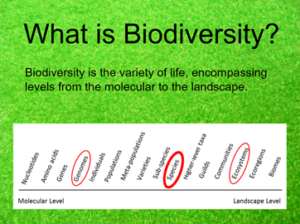
We usually think of it in terms of species, but biodiversity encompasses levels ranging from the molecular to the landscape. In other words, the biodiversity spectrum runs from the building blocks of life at one end to complex ecosystems at the other. Billions of organisms and millions of species occupy the middle stretch, but diversity manifests at all levels.
At the molecular level, genetic variance contributes to differences among members of the same species, allowing for natural selection and evolution. At the landscape level, ecological variance covers countless combinations and interactions among species. In fact, at the landscape level, geophysical features such as ice sheets, canyons, and ocean currents are interwoven with the life therein and thereon.
Biodiversity at all levels changes constantly due to factors including genetic mutation, the evolution of species, ecological interaction, weather and climate, geological forces, and astronomical events. Some of these changes are fairly predictable, while others are or seem random or “stochastic.” For roughly four billion years, none of these changes were influenced by humans.
Prehistoric and Early Historic Effects of Humans on Biodiversity
The co-evolution of Homo sapiens and other species began approximately 200,000 years ago, but it wasn’t until the advent of agriculture early in the Holocene Epoch—circa 10,000 years ago—that humans began having profound, diminishing effects across the spectrum of biodiversity. The negative effects started slowly, then proliferated rapidly.
In North America, for example, there were no widespread, long-lasting human populations (and possibly none at all) until roughly 13,000 years ago. Then, toward the end of the Pleistocene Epoch, Asian hunters were able to emigrate across a frozen Beringia into North America. These hunters had honed their abilities, over evolutionary time, on the Siberian steppes, and they found the wildlife of pristine North America easy prey. Mammoths, mastodons, giant bison, and ancient horses were among the many species to go extinct in a wave of hunting known as Pleistocene overkill, although the hypothesis is by no means a consensus.
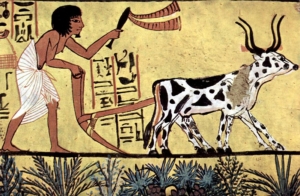
Prehistoric farming, niche expansion, and habitat transformation.
What is far more certain, based on theory and evidence, is the widespread, erosive impact of humans commencing with the origins of agriculture, which in North America ranged from the early to the middle Holocene epoch roughly 10,000–5,000 years ago. Hunting remained a direct threat to non-human species for millennia, but agriculture was a different kind of threat; a more insidious threat, if less bloodily direct. Agricultural plots simply displaced native plant and animal species and their habitats.
Agricultural surplus had synergistic effects with hunting, too. Grain storage allowed humans to occupy areas when game was scarce; game, when available, provided a rich source of calories and protein, allowing for more intensive farming activity. In fact, as if to pre-empt my point on the fundamental conflict between economic growth and biodiversity conservation, agricultural surplus was the primary prerequisite for the very origins of money.
Fast forwarding to the modern period, the human impact on biodiversity accelerated rapidly with the Industrial Revolution of the late 18th century in western Europe, early 19th century in North America, and unto contemporary history in many regions. The impact continues to accelerate as a function of population growth and economic activity; that is, population × per capita consumption, aka GDP. Biodiversity decline is now a planetary trend on the verge of becoming the sixth mass extinction.
Carrying Capacity, Habitat, and Niche Breadth
The post-agricultural and especially post-industrial decline of non-human species follows from basic principles of ecology. The most relevant concepts to start with are carrying capacity, habitat, and niche breadth.
Every species is subject to the capacity of the planet. Each species has its own unique carrying capacity, too. Take pikas and bristlemouths, for example. Pikas are the quintessential alpine obligate—found only among the high peaks—while bristlemouths are the most common fish in the sea, numbering in the trillions. Carrying capacity depends, then, upon environmental conditions (starting most crudely with marine vs. terrestrial) as well as characteristics of the species in question, such as migratory ability and social behavior.
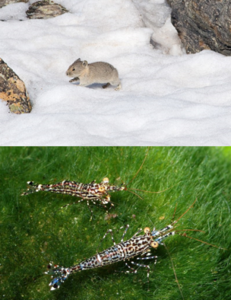
Pikas and rock shrimp: vastly different carrying capacities. (Pika image: CC BY-SA 2.0, Kimon Berlin. Rock shrimp image: CC BY-SA 2.5, Dirk Blankenhaus)
To be more specific about environmental conditions, each species has “habitat” requirements. Habitat refers to food, water, cover and space. Pronghorn antelope need a lot of forbs, very little free water, virtually no hiding cover (except for fawns), and vast spaces in which to see and outrun coyotes and mountain lions. It’s a unique constellation of resources that quite “fits” the size and shape and behavior of pronghorn.
By now you’ve probably detected or suspected that the “spec” of species, specific, special and so on is a Latin root; it translates roughly to “examine.” If we examine the life histories of animals (and plants) we can distinguish special or specific needs for food, water, cover and space among species. Pronghorn needs are different than elk needs, and vastly different than bristlemouth needs. Thus we refer to the habitats of species in the plural, although the singular “wildlife habitat” is commonly used (to the dismay of some) to express a collection of habitats in an ecosystem.
Each species has a niche, too, which can be likened to the species’ “job” on Earth. How does a hummingbird make a living? By extracting nectar from flowers. That’s a pretty specific niche, which over the evolutionary ages has “produced” a unique bird in terms of shape, physiology, and behavior. Coyotes, on the other hand, have a broad niche. They can live just about anywhere above sea level and eat almost anything, although they tend to do best with meat (at various stages of freshness).
All else equal, the broader the niche, the higher the carrying capacity. Red-cockaded woodpeckers eat a wide variety of insects, but they have a specialty of nesting in cavities. They and a long list of other cavity-nesting species have been hit hard by land-clearing and logging, which tends to remove the older trees conducive to cavities. Carrying capacity for cavity-nesting species, then, has been greatly reduced.
A racoon, on the other hand—while it loves cavities too—can get by holing up in just about any crack, nook, or cranny. That and a classic omnivorous diet make for one of the broader niches in nature, and the carrying capacity for coons is generous.
Competitive Exclusion
No species lives in a vacuum; each one competes with others. When niches overlap substantially, competition can become intense. Thus the differences we see among closely related species, such as the Galapagos finches so famously described by Darwin. They evolved—most notably their beaks—to specialize in specific food resources, and/or to avoid competition for other resources.
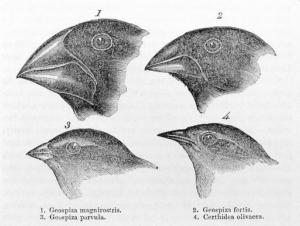
Four of Darwin’s finches: adaptation to competition on display. (CC BY 4.0, nknsyhrt)
With too much niche overlap, competition will come at the expense of at least one species. In fact, the principle of competitive exclusion, aka “Gause’s law” (not to be mistaken with “Gauss’s law” of physics), is that two species with identical niches cannot coexist at length. The tiniest competitive advantage will eventually drive the “lesser” species extinct; a big advantage will do the job faster.
While the niche of a coyote or racoon is broad indeed, it pales in breadth compared to that of Homo sapiens. Men and women can live almost anywhere on the planet and eat anything edible. You might say we have the consummate niche, terrestrially at least, and with no minor presence in the marine realm either. Plus, given our technological prowess, we can outcompete the vast majority of non-human species for virtually any resource we seek. And seek we must, if we insist upon economic growth.
Causes of Endangerment — They’re the Economy
As if the principles of ecology weren’t enough to establish the fundamental conflict between economic growth and biodiversity conservation, the empirical evidence eliminates any doubt. When we look at the reasons for species endangerment in the USA and worldwide as well, we end up with a list of activities and artifacts including agriculture, logging, mining, commercial fishing, manufacturing, urban sprawl, road construction and maintenance, reservoirs and other running water diversions, powerlines and other features of the energy grid, and pollution. Each of these destroy or degrade wildlife habitats.

Chicago: Huge city, intense economic activity, competitive exclusion of non-human species in the aggregate.
While Homo sapiens is making a living—farming, mining, building houses, constructing offices, providing medical care—it is essentially expressing a vast niche and operating at the competitive exclusion of nonhuman species. The effects on wildlife habitat can be overwhelmingly and abruptly destructive, as with paving, or subtle and slow, as with a gradual increase of nitrogen levels in a lake (a common scenario with fertilizers in agricultural areas).
The salient point is that the list of activities and artifacts imperiling biodiversity is essentially a list of economic sectors and infrastructure. We have the agricultural and extractive sectors at the base (farming, mining, etc.), heavy manufacturing sectors (steel smelting, for example) that depend upon the extracted resources, and lighter manufacturing sectors that incorporate and refine the raw manufactured materials. A long list of service sectors assist with agricultural, extractive, and manufacturing activities. Infrastructure (roads, powerlines, canals) is used primarily for the transport of goods and services, as well as individual consumers and producers. Pollution stems from all these activities, with some more notorious than others (chemical manufacturing, for example).
Essentially, then, the causes of species endangerment comprise “the economy.” As the economy grows, it causes more endangerment, extirpation of populations, and ultimately extinction of species.
What about climate change and invasive species, the two other major causes of species endangerment? They only add to the case against economic growth. GDP is the key variable in determining the level of greenhouse gas emissions. Invasive species have proliferated as a function of international trade and interstate commerce, including some intentional transport and subsequent escape (such as with Burmese pythons in Florida) but far more often unintentionally as stowaways (for example, brown marmorated stinkbug).
COP15 Policy Implications
Putting all these ecological principles together with the empirical evidence, we can summarize that, due to the tremendous breadth of the human niche, which only broadens further via technological progress, “economic growth proceeds at the competitive exclusion of nonhuman species in the aggregate.” In other words, we humans are driving a growing list of species extinct and we’ll continue to do so unless we intentionally limit ourselves, or until we breach the carrying capacity of Earth to support us.

In dire need of a good COP.
Most of us involved in conservation biology, ecological economics, and sustainability science are convinced that we—8 billion of us with a GDP of almost $90 trillion—have already done just that: breached our carrying capacity. Such a breach can only be short-term by definition. We’re living on borrowed time, able to do so by liquidating stocks of natural capital including fossil fuels, forests, and fisheries. We either figure out how to move toward a steady state economy at a sustainable size soon, or we will be thrust into environmental and economic chaos. Populations and GDP will plunge due to pestilence, malnourishment, diseases, and war—call them Malthusian scenarios if you like—all amidst a globally heated environment of devastated biodiversity that won’t allow for a glorious comeback.
This time around, then, our biodiversity COP needs to finally get it right. We all need the diplomats, technocrats, and journalists at COP15 to get it right. We desperately need high-level leadership that tells it like it is about the fundamental conflict between economic growth and biodiversity conservation, stops trying to marry the polar opposites of growth and conservation, and calls upon the parties—starting with the wealthiest ones—to get off the growth path and move toward a steady state economy.
Yes, we need a good COP. In fact, we need two of them: COP15 and COP27. With biodiversity, the climate, and innumerable future generations at stake, there’s no room for a bad, “green growth” COP.
 Brian Czech is CASSE’s executive director and served as conservation biologist at U.S. Fish and Wildlife Service headquarters from 1999-2017.
Brian Czech is CASSE’s executive director and served as conservation biologist at U.S. Fish and Wildlife Service headquarters from 1999-2017.

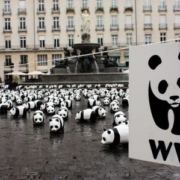
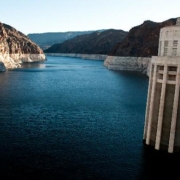
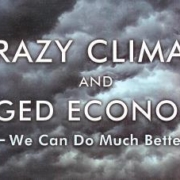
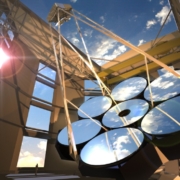
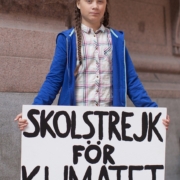


I prefer to highlight the difference between our inability to identify the value of non-commodity resources and the market forces that drive the valuation of commodity resources. Simply stated, the only metric the economists are willing to consider is “How much would you pay to see that last Ivory-billed Woodpecker before it slips off into extinction?” The value of the commodity-based habitat elements are much easier: “How many board feet of centuries-old bottom land forest are present in the [name the forest]?” or “How much is that adjacent lowland oak forest worth if we sell off the timber, build dykes, and flood it for rice production?” -TATE
Took me about 15 minutes to read and digest this article. The bad guys among economists will not read any article linking growth to loss of biodiversity. I wish we could “kidnap” the good-guy economists, like, say, Stiglitz, for only 20 minutes and force them to: 15 minutes to read the article and 5 minutes to recognize the need for sustainable degrowth. Same strategy for news comentators specializing in economics, and for NGOs that espouse “green growth”.
Excellent article, as always. All I can add:
I have a hunch that because humans are pretty inventive, the unpleasant reckoning of borrowed time may first become painful not so much in the form of resource bottlenecks, but in the form of waste sink bottlenecks. Since waste sinks tend to be regarded as “somebody else’s problem”, and so on. One could argue that C02 emissions are an example of the waste sink problem.
I agree with Mark Cramer, it would be useful for all if one could get someone like Stiglitz to sit still with an article like this for maybe 20 minutes, with the attitude of making an honest effort to read and comprehend. A good mantra I have heard from others (in modeling risk) is to say “What if this strange idea is actually right? What then?” That often at the very least gets one to think about ways to measure early signs that a “strange idea” might be right, which I think would get fellows like Stiglitz really thinking (and perhaps alarmed).